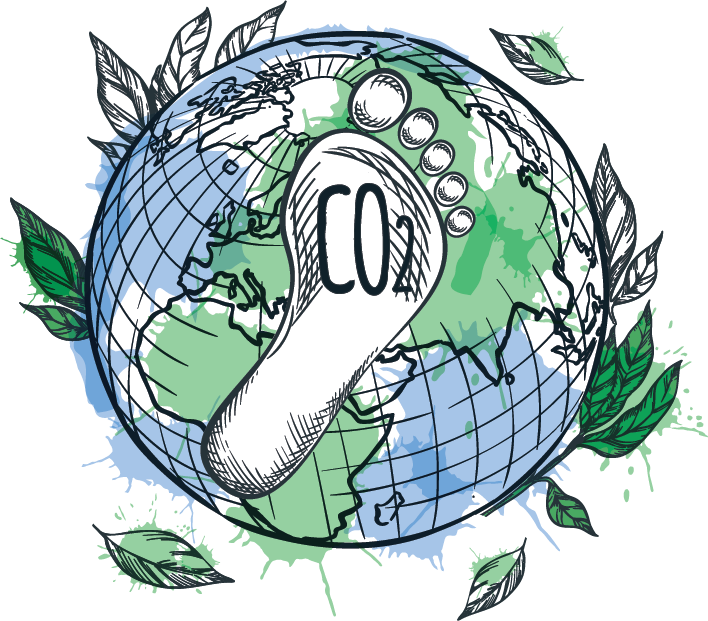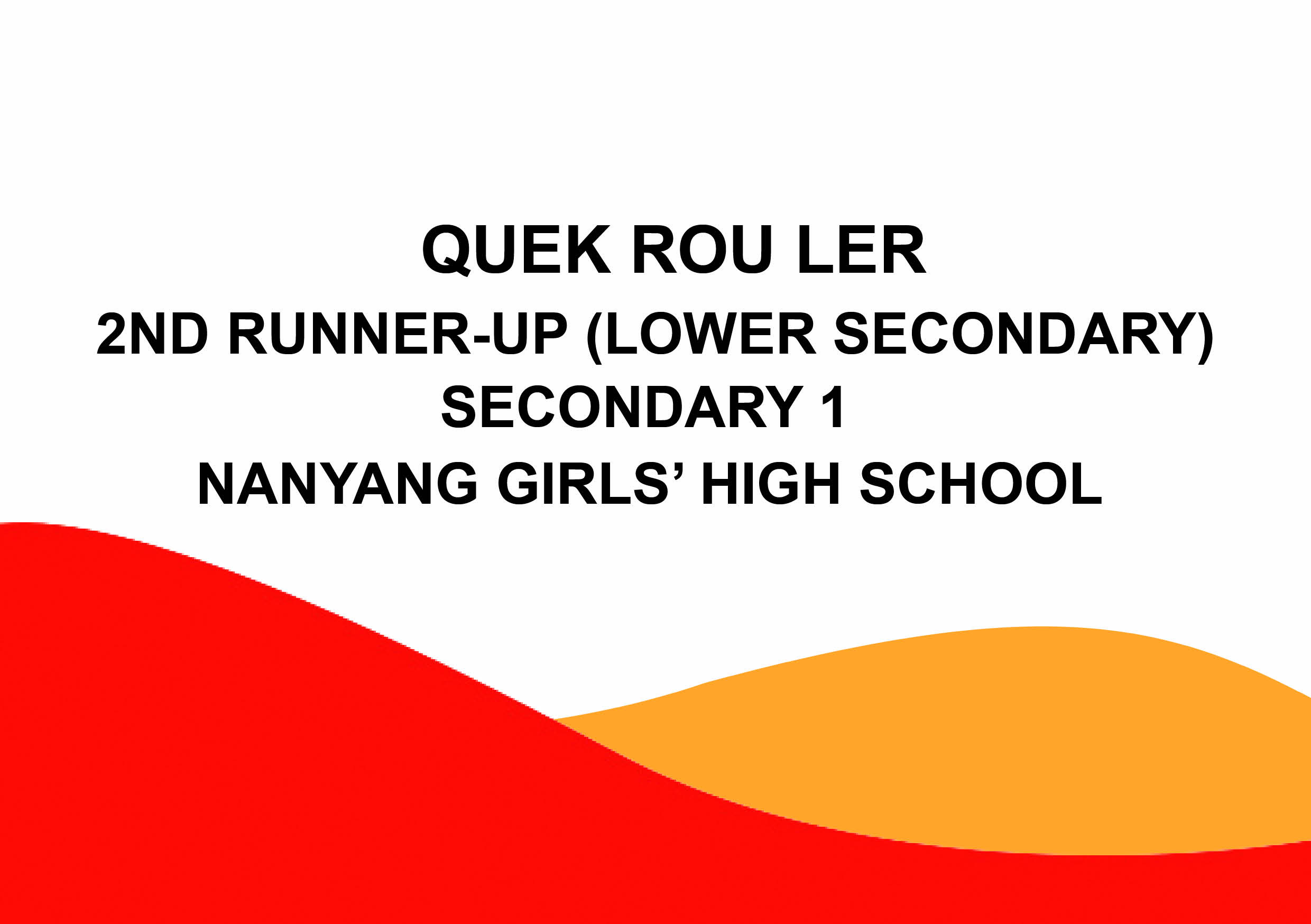2018 Crea8 Sustainability Competition
Our Climate Footprint (Secondary)

In support of Singapore’s efforts towards zero waste, the competition focused on the theme of how we reducing our waste and be part of the solution that leads us to a zero-waste lifestyle. Through poster design, animation video and videography, the competitions sought to inspire students and youths to identify areas that promote sustainability for the future Singapore.
WINNER (LOWER SECONDARY)
Kulkarni Mrunal Makarand
Temasek Secondary School
I was enjoying a FIFA world cup football match between Brazil and Costa Rica. In the break time an advertisement diverted my attention to a completely different topic. It was about Sustainable Singapore campaign, run by the National Environmental Agency. I felt proud to know that our little red dot is committed to contribute to a global cause by reducing our total carbon emissions. Thoughts started clouding in my mind.
In recent decades, many countries around the world are facing severe impact of climate change and experiencing extreme weather conditions like terrible floods, droughts, melting of artic glaciers and rising sea levels. 2016 was the warmest year as recorded. News of burning bats and extinguishing of many other species of Flora and fauna are shaking us.
Singapore has limited land and resources. Rise in daily temperature or more wet months will cause rise in sea levels by the end of this century and may endanger our existence. Keeping this in mind, we have to play our role to fight climate change. It is a duty of every resident of Singapore to support our nation’s pledge to reduce carbon emissions. There could not be a better way to encourage participation of individuals, communities and businesses than setting targets to reduce our carbon footprints. Many thoughts started racing in my mind about how we can contribute towards developing a sustainable Singapore.
In individual contribution to reduce the carbon footprints, behavioral changes will definitely be the key. Start the day taking simple steps for ‘conserving water and electricity’. Minimize the use of water and electricity by purchasing water and energy efficient appliances. Purchase items with Energy Star label or Green Label products to conserve energy by 25-80%. Turn off lights and electrical appliances when not in use. Setting the air-conditioner temperature at 250C, sealing all air leaks will reduce the heating and cooling energy consumption. Proper servicing of appliances to improve the performance by lowering energy consumption. Weatherize your home to make it more energy efficient. Monitor and compare electricity bills. Use washing machine with full loads. Only purchase things you need. Promote use of second hand items. Reduce-Reuse-Recycle of household items, clothing, newspapers, bottles, cardboard, plastic, metal cans or old electronic appliances. Recycle e-waste at designated ewaste recycling bins. Say ‘No’ to plastic. Increase use of reusable shopping bags. Use own reusable containers for hawker food. Use Local Food to reduce packaging and transportation. Minimize use of red meat and dairy products as animals like cows produce greenhouse gases. Prefer walking, cycling for small distances, share and promote use of electrical vehicles.
The Community can also play an important part in reducing carbon footprints by conducting Reduce-Reuse-Recycle campaigns like community recycling. Promote ‘Repair Kopitiam’ projects to combat buy and throw away culture. This will bring the community together to repair and reuse. Set up and encourage public to use e-waste recycling corners, paperless offices. Reduce use of plastic-Styrofoam disposables for community functions. Schedule community gatherings, eco-friendly trips, walks at Green buildings like Our Tampines Hub. Promote community gardening and tree plantation activities to offset carbon footprints.
Singapore is an economic hub of South-East Asia. Businesses must play very important role in sustainability of Singapore by taking right steps to reduce carbon emission and fight climate change. Businesses should decide their percentage target to reduce carbon footprint, according start planning and adopting environment friendly policies. Organize trainings and activities to promote the cause. Use green energies. Start measuring and monitoring organization’s carbon footprints. Go for ‘Green Buildings’ with natural lights and ventilation architecture. Upgrade water-energy efficient systems and equipment to cut down energy requirements. Encourage paperless offices and digital communications. Wherever possible, work from home is another good option to minimize daily travel of employees. Prefer videoconferences over personal business trips. Educate and encourage the staff for 3R. Promoting compulsory activities like Tree plantation will help in offsetting the carbon footprints.
Last but not least the Singapore Government has to play the leading role in reducing our carbon footprints as pledged. Year 2018 has been declared as year of climate action. For reducing carbon footprints government will be introducing Carbon Tax from 2019 mainly for the large polluters. Even for green energy, the government has planned for floating solar panels. It is also encouraging electric car sharing programs and installation of large number of electrical recharge points. Efforts for efficient public transport network and decent bicycle – walking trails will help in reducing the number of private vehicles.
Moreover, government need to organize more awareness programs to fight climate change, promoting recycling-reuse culture in Singapore. Taking some steps like increasing ewaste collection centers, promoting ‘Repair Kopitam’ projects, promoting sell of recycled items at lower prices, conducting more repair- reuse-recycle courses in schools, running awareness programs for waste collecting agencies, Karang guni persons, etc. Banning some plastic items or reducing plastic usage, promoting sellers- supermarkets to give discounts on use of reusable bags, containers, tax hike for more packaging. Promoting local products and food. Credit program for businesses using paperless offices, Green buildings, digital currencies, e-communications, green energies, water and energy efficient systems, waste management system, public awareness program.
For reduction in the use of fossil fuels Government can promote use of green energy, lowering prices of cycles, limited speed e-scooter, e-cars, solar panels, solar appliances. Applying higher taxes for vehicles using fossil fuels, businesses using petroleum products. Rebates for those managing lower energy consumptions. Installation of more solar panels on rooftops of HDB housings, streetlights and public places. Welcoming businesses generating clean energy, incentives for more use of public transport, credit points for students and businesses to engage in awareness and tree plantation activities may also help.
When my mind came back to the football ground, my favorite team Brazil had already won the match. Now, it is time for us to play our best to win against carbon footprints. I scored the first goal for our nation by switching off the T.V. and lights of my drawing room before going to bed.

1ST RUNNER-UP (LOWER SECONDARY)
James Foo Man Han
Punggol Secondary School
Singapore, as a small country island, has a carbon dioxide emission of 10.3 metric tonnes per capita as of 2014, almost as much as Russia, the biggest country in the world, at 11.9 metric tonnes per capita! Obviously Singapore has to change and the government has set a target that by 2030, they will reduce the carbon dioxide emissions. I personally feel that there are a lot of ways that Singapore can reduce its carbon emissions.
One way is to improve on its existing laws to make it even harder to get a car and to actually maintain it too. This process, which currently just requires the needed amount of money, should include questions about why he or she really needs the car. The owner should also be asked to sign a form that states that he or she should always carry at least half the total capacity of the car. This way, the carbon dioxide emissions per capita will be lowered and thus decreases the carbon footprint. To prepare for the increased amounts of traffic flow to public transport, the government should make the transport system more reliable as this would increase the trust between the passengers and the public transport system, so that the people who are new to the transport system would not go back to using their cars. They should make it easier to understand the system so that the new users would not be confused.
Another way is to ban driving once every week, as what Mexico has been doing to save the environment. Adopting this system would allow for the car owner to be forced to use public transport and maybe, he or she might eventually get comfortable and take public transport everyday. The system also allows for those who try to cheat the system to be caught and fined due to number codes which allow for traffic police to catch cheaters. For example, on Tuesday, vehicle plate numbers ending in 7 and 8 will remain parked. Those ending with 3 and 4 will do so on Wednesdays, those ending with 1 and 2 on Thursdays, 9 and 0 on Fridays and those with 5 and 6 on Mondays.
The other way Singapore could reduce its carbon footprint is to reduce the amount of electricity it uses or to find renewable sources of energy. In addition to the additional tariffs and taxes to deter people from using too much electricity, the government should invest in research for a device which can automatically switch off different appliances at different times of the day. The appliance ratings should have more higher tiers which have stricter standards and if a company is able to meet the requirements, Singapore will buy more so that it can be discounted for the buyers. The government should also make the tier standards that all residents must follow that increases every few years. This would allow for enough time for everyone to change out the appliances and if financial aid is needed, should be given. All houses that do not already have an LED light bulb should get a free LED light bulb so that they can trial how much more better the efficiency of an LED light bulb is, and hopefully buy more for the house.
Singapore should invest in research for cheaper ways to produce solar panels and should lead the way for clean energy as a rapidly developing nation. This way, Singapore can install these cheaper solar panels and normal residents can also harvest solar energy. The residents can help maintain these solar panels and if there is excess energy, the can feed it back into the powergrid. The government should also reward these residents with bill coupons so they can use it next time. In addition to rooftop solar panels in HDB flats, they can install small and short wind turbines that can convert small amounts of renewable wind energy into electricity as the rooftops of these HDB flats are usually windy.
Singapore can and should try to decrease the amount of imports from far away places it makes as these will increase the carbon footprint due to the shipment transportation’s large amounts of carbon emissions. Singapore should make local produce or open up small farms in surrounding countries that have lots of land, for example our neighbouring country, Malaysia. We can built climate control greenhouses like how we did for the tourist attraction, Gardens by the Bay’s cloud forest and flower dome. These climate control greenhouses can produce plants like strawberries or different temperate country grown plants. In addition, Singapore can call these plants their own or even create hybrids and name it as its own type of plant. They should make a special industrial only causeway bridge to carry these goods without any need for a traffic jam such as in Woodlands or in Tuas checkpoint.
These are the right steps I feel that the government should do to be able to achieve the 2030 target to reduce Singapore’s carbon footprint. With this, Singapore could even achieve its target way before 2030 and could even aim higher for the future generations to come who should be able to live this world as well as the adults of this century lived, carefree about the environment, of course with it being healthy and beautiful as it was before.

2ND RUNNER-UP (LOWER SECONDARY)
Quek Rou Ler
Nanyang Girls’ High School
Based on the most recent International energy agency(IEA) data, Singapore ranks 26th out of 142 countries in terms or emissions per capital despite its small land area. However, we are taking steps to tackle this problem to achieve our emission target of greenhouse gas emissions peaking at about 65 million tonnes of carbon dioxide for each GDP dollar to 0.113kg per dollar.
The government has implemented many plans to reduce carbon emissions. From 2019, a carbon tax of $5 per tonne of greenhouse gas emissions will be charged to facilities which produce 25000 tonnes or more greenhouse emissions. This encourages companies to use more renewable sources of energy instead of fossil fuels by placing a price on the carbon emitted. Another initiative by the government would be to replace oil with more environmentally-friendly and less carbon intensive alternatives. This has resulted in natural gas representing over 96% of our energy mix in 2016. Singapore has also increased its solar capacity as a measure to diversify its energy mix.
Singapore is also taking measures to reduce emissions from the industry sectors. A good example would be the Energy Conservation Act. From April 2013, companies in the industry and transport sectors who use more than 15 gigawatt-hours of energy per year will have to appoint an energy manager, monitor and report energy consumption and greenhouse gas emissions, as well as submit plans to improve energy efficiency. By improving our energy efficiency, carbon emissions will be cut down as lesser electricity is needed and lesser fossil fuels will be burnt.
To reduce emissions from motor vehicles, Singapore implemented the Vehicular Emissions Scheme(VES) at the start of 2018. The VES tracks five pollutants: Carbon Dioxide, Carbon Monoxide, hydrocarbons, nitrogen oxides and particulate matter to reduce harmful vehicle emissions. The rebate and surcharge for vehicles will then be determined by the worst-performing pollutant. The VES has two bands: rebate of $10,000 or $20,000, and surcharge of $10,000 or $20,000.This encourages buyers to purchase more environmentally-friendly models with lower emissions, improving the air quality and reducing the emissions caused by motor vehicles.
Even though I think these schemes have been effective in reducing carbon emissions, more needs to be done to reduce carbon emissions from the households of the general public.
I firmly believe that we should spread awareness for recycling as recycling reduces industrial emissions as lesser goods need to be manufactured when more materials are recycled. Recycling is also a bit to reduce emissions from incinerators as less waste products are burnt. This shows that recycling has a huge impact on reducing carbon emissions. Despite our efforts to make recycling more convenient with programmes like the National Recycling Programme (NRP), which allows paper, plastic, glass and metal recyclables to be deposited to the same blue recycling bin for collection by recycling trucks, the household recycling rate still remained at only around 20 percent between 2005 and 2015. To make matters worse, 30 to 50 percent of materials in the recycling were unsuitable for recycling due to recycling contamination. This shows that the general public still lacks awareness for recycling, hence I propose a few initiatives to encourage more of the public to recycle the right materials.
An important step to take would be to educate the public on recycling. For the younger generations, recycling can be encouraged and taught in schooling from a young age. For example, children in pre-school can create arts and crafts with recycled materials, whereas students in Primary School and beyond can be educated on the impacts and ways of going about recycling through lessons taught in school, as well as attending talks and learning journeys on recycling. Examples would be recycling drives and educational trips to recycling facilities held on Youth for the Environment Day. This not only gives them a hands on experience on the different methods of recycling, it also influenced and encourages them to recycle. Competitions such as Crea8 sustainability competition alos encourage students to think deeper into environmental issues.
Through education for the young, they can be more aware of recycling contamination, which will allow the children and students to learn to bin or recycle materials appropriately.
When the younger generation recycles, this will in turn influence adults to change their bad social behaviour. Elderly residents, having very little or no knowledge of how to recycle because of their lack of activity on the Internet will be able to pick up correct recycling habits from the younger generation. Additionally, television and radio channels can advertise the benefits and correct methods of recycling, as the message will reach most households.
Another measure to take would be to have strict laws issued by the government in order to make recycling contamination and waste disposal a deterrence for the public. A current example would be the regulation set by the Government to ensure that e-waste is recycled instead of disposed. Further action has to be taken to ensure that other than e-waste, other recyclable materials will be recycled as well. Incentives can be given to those who actively and correctly recycle their waste. An example for a reward system would be the Cash-For-Trash Programme in Pasir Ris-Tampines residents will be able to exchange their recyclable items for cash when they bring them to the nearby recycling station. Besides this initiative, “Happiness Arcades” rewards users with a pong-like game for every empty can recycled. With this new initiative, recycling bins can be seen in a fun and enjoyable light as happiness is used to change social behaviour. Hence, I hope that more of such stations can be placed in our neighbourhood as they are very different from carrots and sticks, with joy being the reward derived from recycling for both initiatives. Hence, recycling is strongly promoted.
With all these efforts put in place, as well as the wide range of ideas that can be carried out, I believe that the path to lower Singapore’s carbon footprint and achieve our emission targets has never been brighter.

WINNER (UPPER SECONDARY)
Agrawal Praakar
Raffles Institution
One of the defining challenges of the 21st century, climate change has impacted the health of nations and civilisations globally. With rapid industrialisation and skyrocketing greenhouse gas (GHG) emission rates, the climate is deteriorating; sea levels are rising at 1.8mm/year, food security is diminishing and insect-borne diseases are spreading. Singapore faces a similar climatic issue too. Despite the government’s active stance towards mitigating climate change and ensuring a thriving environment, the environment’s sustainability is being undermined. To combat climate change, Singapore can implement solutions both locally and nationally; through raising public awareness, investing in energy-efficient buildings, exploring renewable energy sources and striving towards a car-lite society.
Firstly, increasing awareness about climate change is paramount to convince and incentivise Singaporeans to play a part in conserving the environment, and should be coupled with education from young. Environmental conservation should be incorporated in the school curriculum through various means; such as assembly programmes, a school ‘Environment Club’ and learning journeys to places with fragile environments. Such initiatives teach students about the importance of managing precious resources; motivating the young to actively contribute to environmental sustainability. Schools can also organise activities for students on occasions such as the ‘Youth for the Environment Day’ to enhance their understanding of climate change through play; with different initiatives for primary, secondary schools and junior colleges. Cumulatively, these initiatives would raise significant awareness about climate change; encouraging citizens to participate in activities to individually reduce their carbon footprint. Local community clubs provide several avenues for citizens from all walks of life to participate in eco-friendly projects. Workshops and activities such as tree planting, learning trails to nature reserves, creating handicraft items from recycled materials (such as reusable bags) to sell and collecting funds for environmental conservation can be carried out. Posters can be put up around residential estates and common spaces and house-to-house visits can be carried out to encourage locals to conserve energy, reducing net GHG emissions and contributing to environmental sustainability.
On a national scale, investment into energy-efficient, green buildings may yield success in reducing Singapore’s carbon footprint. Through deliberate designs and installations, green buildings optimise resource usage and consume energy sustainably. Current energy-efficient buildings use both passive designs which tap on nature, such as vertical gardens and solar energy, and active building solutions, including sensor and motion based LED lights, water cooling systems and light shelves to utilise natural light than artificial lighting. These green buildings are extremely effective in reducing Singapore’s carbon emissions. According to a 2016 report by the United Nations Environment Programme, the emissions savings potential of green buildings is as much as 84 giga tonnes of carbon dioxide (GtCO2) by 2050. However, Singapore has insufficient green buildings to reach the Inter-Ministerial Committee on Sustainable Development’s (IMCSD) 2030 target of 80% Green Mark Certification for all buildings. investment into green buildings by the government would not only encourage building owners to strive for high Green Mark Standards to reach IMCSD’s target but also potentially develop newer, green technologies. As such, investment into green buildings would enable Singapore to meet its target and greatly assist in reducing carbon footprints, promoting sustainable development and environment conservation.
Furthermore, Singapore should utilise alternative sources of renewable energy to generate electricity. To meet its energy demands, Singapore primarily relies on fossil fuel burning which releases up to 44.4 million tonnes of CO2, according to 2015 data from the International Energy Agency (IEA), into the atmosphere which traps longwave radiation and increases temperatures. Being a finite resource, fossil fuels will eventually deplete as well. To ensure sustainable energy production and conserve the environment, Singapore can tap on naturally replenishable energy, coupled with its smart nation initiative. One source is solar power, which converts light energy into electrical energy, as implemented in Punggol New Town. Located 1°N of the equator in the tropics, Singapore receives abundant light all-year round, making solar energy a sustainable energy source. Furthermore, solar panels do not require additional land area and can form ‘energy islands’ on the sea; advantageous considering Singapore’s limited land area and surrounding straits. Although the production of solar panels is costly, the government can offer subsidies to building owners for such major energy-efficient installations; similar to the ‘Building Retrofit Energy Efficiency Financing’ (BREEF) scheme which encourages building owners with limited finances to go green with additional financing. Installing solar panels in residential estates, commercial hubs and recreational spaces would significantly reduce Singapore’s GHG emissions and carbon footprint, conserving the environment.
Last but not least, Singapore should strive towards a ‘car-lite’ society by making public transport a more attractive option. According to 2014 data from the National Environment Agency (NEA), transport accounted for 15.8% of Singapore’s energy (from oil) consumption – a significant percentage – with private transport contributing a major percentage. Moreover, gases released from vehicular exhaust in vast quantities, such as carbon monoxide and nitrogen oxides, trap heat and contribute to high temperatures. To reduce the atmospheric concentration of such GHGs and burn less oil, a shift from private to public transport is needed through increasing the latter’s convenience and accessibility. Increasing the capacity and frequency of buses and trains as well as expanding rail networks through schemes and long-term plans would improve the reliability and efficiency of public transport; increasing its quality and possibly encouraging locals to opt for public than private transport. As buses and trains are able to transport greater passengers than individual cars per unit CO2 emission, striving for a car-lite nation would reduce the country’s carbon footprint and promote environmental sustainability.
In summary, to mitigate climate change, Singapore should raise public awareness, invest in green building technologies, explore renewable energy sources and aim towards being car-lite. Climate change is a global issue and requires the concerted effort of all nations globally. Ultimately, our collective action will determine the future of our planet, our children and humanity. The most massive tsunami, disastrous epidemic and perfect storm is bearing down upon us, with an increasingly grim reality. The day that man is unable to control climate change is the day we unleash the terrors of Pandora’s Box.

1ST RUNNER-UP (UPPER SECONDARY)
Koh Wei Lun
Compassvale Secondary School
Singapore’s greenhouse gas emission is expected to reach 77.2 million tonnes in 2020 of which 60.3% is contributed by the industrial sector (National Climate Change Secretariat [NCCS], n.d.). This means that if the industries do not make adjustments to their industrial processes, the carbon footprint in Singapore can only set to increase further.
In order to decrease the carbon footprint in Singapore, we need to think of solutions which primarily focus on reducing industrial carbon dioxide emission. The making of industrial products typically produces a lot of waste gases which are released into the atmosphere. These waste gases are typically treated to remove air pollutants such as sulfur dioxide. However, carbon dioxide usually makes up a significant amount of the waste gases. To prevent carbon dioxide from being eventually released to the surroundings in the form of waste gases, a tube can be connected to the side of the chimney where the waste gas escapes. Through the use of suction force, carbon dioxide can be collected and stored as dry ice to save space. When carbon dioxide exists in the gaseous state, its huge volume takes up a lot of space. By converting carbon dioxide into dry ice through the sublimation process, its volume is drastically reduced and it can be stored underground in a deep-freezing chamber to drastically reduce the use of space in land scarce Singapore. When necessary, the dry ice can be converted back into carbon dioxide in its gaseous state. Carbon dioxide can be used to manufacture chemical and pharmaceutical materials such as urea for fertilisers and methanol. However, one disadvantage is that it is energy consuming to store dry ice as the temperature of the deep freezing chamber needs to be maintained at below -78 degree Celsius since dry ice has a sublimation point of -78 degree Celsius.
A simple illustration of how the carbon dioxide produced could be stored as dry ice in underground deep freezing chambers is included below.
Another main cause of an increasing amount of greenhouse gases in the atmosphere is due to the use of transport vehicles. Motor cars use fuels such as petrol to move from one place to another in a timely and convenient manner. However, this modern convenience brings about the production of air pollutants such as carbon monoxide and oxides of nitrogen. Although catalytic convertors are installed in most transport vehicles to convert harmful gases to harmless gases, it also converts carbon monoxide into carbon dioxide which remains as one of the biggest source of carbon dioxide. The release of carbon dioxide into the atmosphere brings about detrimental impacts on the environment.
One solution would be to develop rechargeable battery-powered motor vehicles. Studies have shown that use of batteries can eventually decrease the number of carbon emissions into the air (Media, 2018). Hence, the use of rechargeable batteries is a feasible alternative to using natural gas to power motor vehicles. This could drastically reduce the use of petrol to power motor vehicles as well as decrease the amount of carbon emissions into the air. The battery could be recharged by using futuristic tires to generate electricity when driving on the road. This could be achieved by converting mechanical energy, caused the rubbing of the tires and the gravel on the road, into chemical potential energy which could be stored in the battery. In the future when our technology is more advanced, scientists can also invent tires that makes use of the mechanical energy produced from the spinning tire which has rotational kinetic energy, to convert it to heat energy. Heat energy can then be converted into chemical potential energy to be stored in the battery. The battery does not produce any sort of carbon-containing compounds which could be released into the air and cause harm to our environment. Should the rechargeable battery in a motor vehicle run low when it is in use, a signal will be in place to alert both the driver and nearby cars in the form of a bright blue light to warn the driver that the battery is about to run out as well as to warn other drivers to slow down in case the motor vehicle suddenly comes to a stop. An extra compartment could be included at the back of the car as to store and provide the driver with an additional battery if the battery in use runs out of power. When the battery runs out of power, drivers can recharge it from the power outlet in their homes.
In conclusion, climate change is a global phenomenon that has led to significant detrimental effects on the environment. The increasing rate of production of carbon dioxide must be curbed in order to reduce the effects of climate change. We must constantly innovate and make use of technological advances to implement creative and effective solutions that reduce the effects of climate change on our environment.
References:
(n.d.). Retrieved June 15, 2018, from https://www.nccs.gov.sg/climate-change-andsingapore/national-circumstances/singapores-emissions-profile Media, J. A. (2018, January 23). How Batteries Reduce Carbon Footprint. Retrieved June 15, 2018, from https://storentech.blog/2018/01/22/how-batteries-reduce-carbon-footprint/

2ND RUNNER-UP (UPPER SECONDARY)
Rahul Pradhan
Westwood Secondary School
How does Singapore achieve its 2030 emissions target?
The environment is on its back, bedridden and vulnerable, all because of us. We now reap what we had sown decades ago during the Industrial Revolution. Major natural calamities, which have claimed millions of lives in the past few years, are the repercussions we have to endure due to the increase in global warming. These temperature increase is caused by the excess greenhouse gases that stay in our atmosphere, which trap radiation emitted by the earth. The amount of greenhouse gases has been proliferating in the 20th century due to overpopulation, incineration and deforestation, and the extent of this has kept increasing over the years. What we have taken no account for in the past has become a severe threat for us today. The only way of reducing the effect of global warming is to reduce the emission of carbon to a very low percent. Many countries are trying to achieve this, with Singapore hot on its heels.
Singapore has a couple of irons in the fire when it come to the topic of greenhouse gas deterrence solutions. The one thing that is delaying our achievement is none other than plastic. With the increase in population over time, Singaporeans have been using more and more plastic. We use over 27 billion plastic bags a year amounting to a waste of about 200 million kilograms of crude oil and natural gas. Out of this, only seven percent of it was recycled last year. More than half of them were dumped in landfills and the rest were incinerated. However, this is a mere fraction of the nation’s plastic waste which amounts in about nine hundred thousand tonnes. This is a colossal issue as plastic emits greenhouse gases when burnt and react to chemicals in landfills to produce methane. However, there might be an alternative which reduces the negative effect of plastic entirely.
Hemp is a miracle crop that you might have never heard of. It can be used to make paper and clothes. But, there is also one significant use for this plant, which is plastic. Hemp cellulose can be removed and used to make a range of plastics. Hemp is known to contain around 65 percent cellulose and is environmentally sustainable. The cellulose is mixed with an array of chemicals to make it extremely durable, for the manufacture of bottles and even cars, but still allows it to biodegrade.
By making all plastic hemp plastic, we just open ourselves to a myriad of possibilities that could be extremely beneficial for our nation. Hemp plastic does not rely on oil based chemicals, so it is not a good fuel of combustion. Because of this, power companies would stop using plastic as fuels for their power stations and would look into better alternatives like natural gas. Secondly, landfills are another area that will be benefitted by hemp plastics. Landfills are a problem as more than 50 percent of the national plastic waste are dumped on it annually and these plastics react to produce methane, moreover they hog precious land. Hemp plastic is biodegradable. This means over time, hemp plastic would deteriorate into the ground leaving no trace of harmful gases and leaving the land occupationally mobile once again. Hemp plastic could be circulated through major plastic manufacturers in Singapore.
Like everything, hemp plastic too has a downside. The reason why no nation is a hemp plastic nation yet is because hemp plastic is relatively new so, Singapore has to invest a sum of money to research on hemp plastic to make it cater to more plastic products like foam. But this research would allow Singapore to spearhead this initiative globally. Another issue is the cost of hemp. Hemp is relatively affordable and can be grown in Singapore itself. However, there is a major space constraint In Singapore, so hemp plastic or hemp must be imported from other countries which might incur more money than its oil produced counterpart. This might be a temporary problem as hemp prices might plummet due to export in Singapore.
Lastly, most plastic from Singapore come from other parts of the world. This is a major problem as the increase in plastic products brought from other parts of the world might dig its claws in this initiative and taint it. The solution of this can be expressed in a simple quote ‘Baby steps’. As they saying goes there is no elevator to success, you have to take the stairs, similarly hemp too will need us to strategize. Hemp plastic could be used for every plastic amenities like the frequently used plastic bags. We can keep progressing from there. Many might think that the game might not be worth the candle, but just a little jostle might propel us to our goal.
Abraham Lincoln once said “I walk slowly, but never walk backwards”. An old adage it may seem, but it has never been truer, than it is in this era. The world is constantly looking for a step forward in reducing global warming. But, every time we move forward a step, because of some inconsiderate people we move two steps back. It is time for Singapore to lead the world in the path because we have resources and the fact that we are small, makes things easier for us to be at the forefront.

